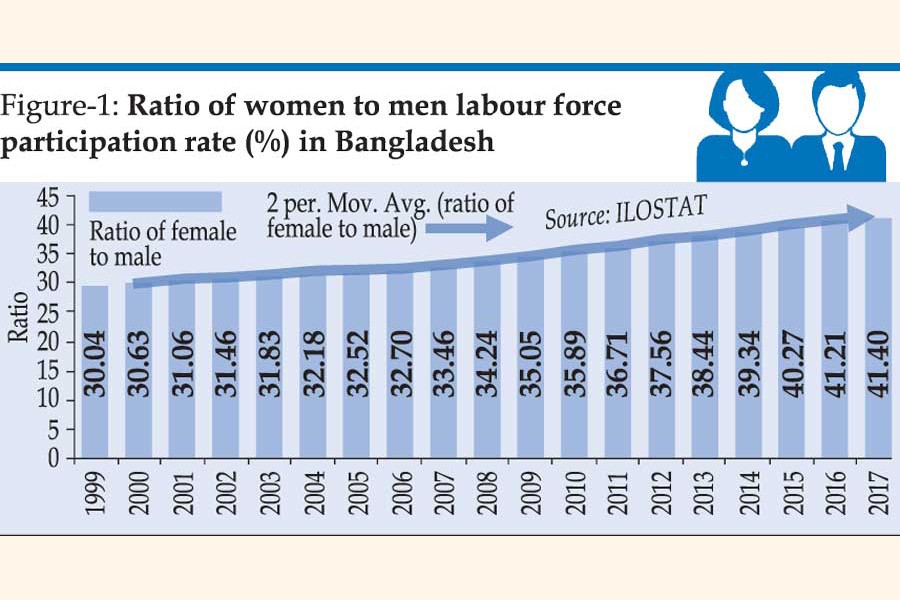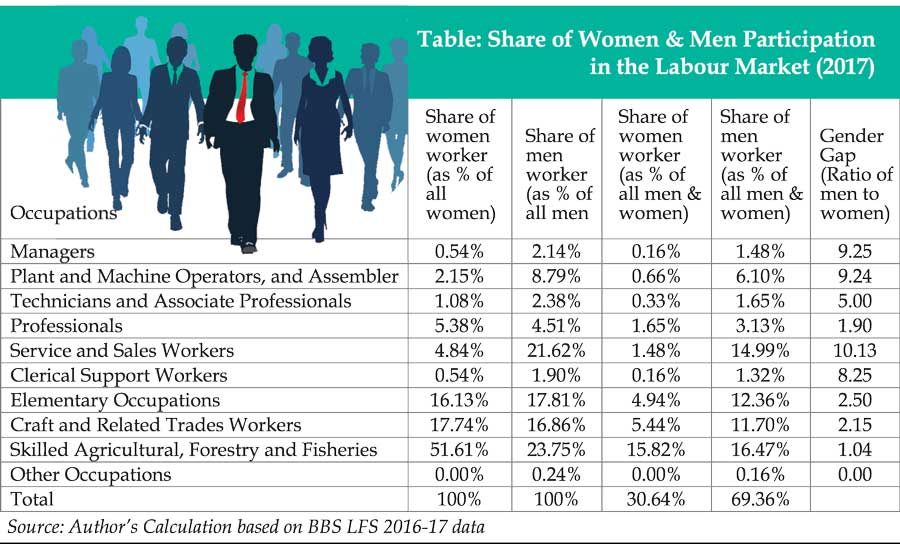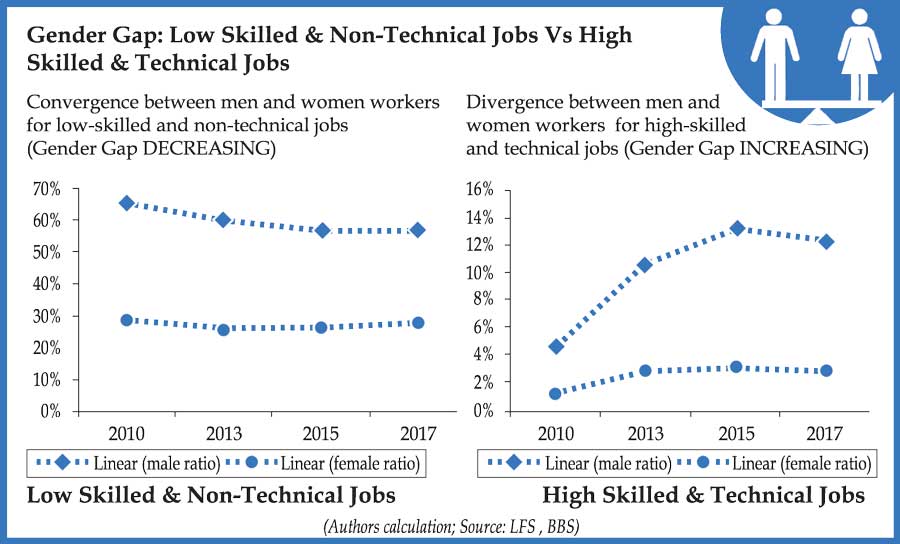
Gender gap in employment
Women have low share in quality, gainful jobs
Rahat Syful Hoque | Wednesday, 13 November 2019

 One of the most striking labour market trends in Bangladesh has been the transformative rise of women in workforce. Over the last 20 years, the participation of woman in the labour force has increased from 24 percent to 36 percent from 1999 to 2017 (figure-1). It's a good start, however, this tells only a part of the story. The progress seems unequal when it comes to the pattern of jobs women are involved in as jobs vary enormously in nature, condition, pay and quality.
One of the most striking labour market trends in Bangladesh has been the transformative rise of women in workforce. Over the last 20 years, the participation of woman in the labour force has increased from 24 percent to 36 percent from 1999 to 2017 (figure-1). It's a good start, however, this tells only a part of the story. The progress seems unequal when it comes to the pattern of jobs women are involved in as jobs vary enormously in nature, condition, pay and quality.
The gradual transformation of the economy from agriculture to industry and service sectors created more paid industrial works and salaried jobs in services and sales. These have certainly created job opportunities for women, but mostly in the bottom of the work-ladder. Women in Bangladesh are facing challenges at every stage of labour market from attraction to retention, entry to advancement, and recruitment to rehabilitation. As a result, gender differentials in labour market outcomes still remains a major cause of concern.
Incentives for empowering women to get access and participate in economic activities alone cannot confirm full and equal participation. Women are still more likely than men to stay out of the labour force. Only 19.96 million (36.3 per cent) out of a total 55 million working age (15-65) women participated in labour market in FY 2016-17 - far below than that of Nepal (80 per cent) and Vietnam (77 per cent). Majority of employed women (75.48 per cent) are working in agriculture, craft and related trades workers and elementary occupations. Even in the formal sector, for example; in the manufacturing factories, which absorb the lion-share of women labour force, most women are engaged at low level with low returns to labour. More than one third of women in labour force are primarily engaged in non-market activities, such as, unpaid household work and as care givers of children and elderly at home.
Particularly, women at present are still far behind men in quality and gainful employment. Like in many developing countries, the labour market for women in Bangladesh is evidently characterized by certain type of informality, occupational segregation, low productivity, low wage, that is low quality jobs that are not gainful. Quality and gainful employment can be referred to jobs, lead role jobs, skilled and technical jobs, professional jobs and high salaried jobs etc. that are formal.
The figure-2 show how the gap in employment between men and women over time is gradually closing down for only low skilled and non-technical jobs but widening for high skilled and technical jobs, despite increase in women participation in the labour market.
The disaggregated occupation wise analysis of LFS, 2017 data shows that, women are way underrepresented in managerial, technical (Plant and Machine Operators, and Assembler and Technicians and Associate Professionals) and professional jobs where only 2.8 per cent of women as of total employed workforce is working as against 11.36 per cent employed men in those high-skilled and technical jobs.
The largest gender gap is seen in managerial positions (chief executives, senior officials and legislators, administrative and commercial managers) - the number of male managers (1.48 per cent) is 9.25 times higher than female managers (0.16 per cent). The gender gap figure is the same for 'Plant and Machine Operators and Assembler' occupation. For 'technicians and associate professionals' the number of male) is 5 times higher than female and in the 'Professional' category (science & engineering professionals, health & education professionals) the number of male is 2 times higher than female. This implies that, labour market for women is getting skewed for quality and gainful employment.
On the contrary, gender gap in employment is seen trickling more into the low-skilled and non-technical employment. Share of women worker as of total workforce (15.82 per cent) in 'Agricultural, Forestry and Fisheries' are very close to that of men (16.47 percent). Participation gaps between occupations can provide further evidence that, about 90.85 per cent women are working at low-skilled and non-technical occupations- more than half of women (51.61 %) work in the occupation 'Agricultural, Forestry and Fisheries', 17.74 per cent in 'Craft and related trades workers', 16.13 per cent in 'Elementary', 4.84 per cent in 'Services and sales occupation' and 0.54 per cent in 'Clerical positions'.
For all these categories the gender gap is declining with exception to 'Services and Sales' (sales staff, security service staff), where 1.48 per cent women are working as against almost about 15 per cent men as of total workforce. An intuitive explanation for this exception is that, in rural areas sales and service jobs are still male dominated.
Why gender gap is converging only toward low-skilled & non-technical jobs? An intuitive explanation of the scenario could be that, at the high end jobs, the entry is limited as majority of women in the labour market lack education, skill and technical knowledge.
An intuitive explanation of the scenario could be that, at the high end jobs, the entry is limited as majority of women in the labour market lack education, skill and technical knowledge.
Women with no or low education (below primary level) make the major part (60 per cent) of the women workforce followed by 31.7 per cent employed women who has secondary level of education. Only 4.3 per cent and 3.4 per cent employed women have higher secondary and tertiary level of education respectively. Although, the tertiary education group has the highest labour force participation rate (56.9%); educated unemployment is more prevalent in case of women compared to men. Lowest labour force participation rate (LFPR) for women is also observed among young girls (15-24 years of age) with secondary, post-secondary education group which is about 30.8%. Many of these women with no or low education are forced to participate in the workforce mainly due to poverty and financial challenges they face from various shocks and disasters and mostly involved in low productivity and low paid part-time informal jobs.
About 92 per cent of youth women (aged 15-29 years) and 85 per cent of all women (age 15-65 years) are not in education, employment or training (NEET) (BBS, 2018). Very few women as compared to men are attracted to or participated in vocational and technical training programmes, which contributes to wider women participation gaps between technical occupations and non-technical occupations. At the same time, more male workers then women are shifting to high end lucrative and technical occupations by attaining skills and trainings.
That is, a severe lack of human-capital exists for women in securing higher-paying high-skilled and technical jobs. The impact of technological change in the age of automation also seems to have more skewed effects on women with low-skilled, less knowledgeable about operating different machines and technical tools and less prepared to take the challenge as compared to their men counterparts. There is also possibility that risk of automation and skill-gap can transmit from high skilled and technical jobs to low-skilled non-technical jobs that could aggravate the scenario.
Again, at low level jobs, there is no limit as education and skills are less desired. That is why; share of women in low end occupations has been increasing. So participation gap tends to converge at lower end jobs and diverge at high end jobs.
Women in particular, as compared to men, face barriers to create better access and gainful opportunities due to differences in the level of other endowment of social wealth, dual responsibility at home and work, structure of values and other social stigmas.
Entrenched gender discrimination in workforce and workplace and lack of work-family balance are two of the major constraints that are overwhelmingly driven by policies and norms rather than any innate differences between men and women in average suitability. Women's propensity to participate and retention in jobs and advancement to the lead roles in the labour market is determined by current and future labour market conditions, better access to child care facility, longer maternity leave, transport, and toilet facilities, more care services for minors or dependents at home, early marriage and early child bearing, and overall security from harassment, discrimination and violence. Women tend to congregate in occupations that either predominantly done by women and in sectors where the majority employees are women. These jobs are mostly feminized, undervalued and non-technical.
All these challenges come together as the reason of differences and discrimination toward women at workforce and workplace that constrained women not only participating in the labour market, but also in high-skilled, lead role, technical and professional occupations.
Way forward
The rising discrimination between men and women in the labour market has all the potential to widen further the overall gender inequality and exclusion and, thus, deepen economic dependence and poverty level for women. Hence, labour market policy and conditions should seek to create quality and gainful jobs to attract and accommodate both men and women equally and harness all available talents for improving labour market outcome if jobs are to be transformative for women's empowerment. Government investments in education, health and other social wealth are supposed to strengthen endowments of both men and women workforces equally that will be put to productive use. Lack of quality job condition and gainful jobs also push prospective skilled and educated women workers away from mainstream labour market. This is one area where policymakers need to focus for deploying women workforce and optimizing it for overall economic outcomes. Development policy and programs need to target young women to prepare them as skilled and trained mainstream workforce, and tapping talented young women into leadership and managerial roles.
................................................
Rahat Syful Hoque is an economist and development researcher. israhat@gmail.com